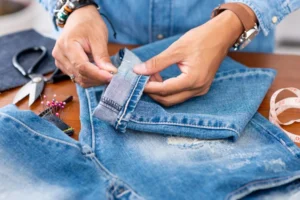One of the main sources of pollution in the world is the fashion sector. Over the past 20 years, fast fashion has grown dramatically, with severe social and environmental effects. The climate change caused by the fashion industry is disastrous. In this post, we provide you with practical information regarding upcycling in the fashion world.
Fashion and Environment
Each year, it contributes to more than 8% of all global carbon emissions. By 2030, the CO2 emissions from the garment and textile sector will have increased by 50%. Thus, every piece of clothing we buy affects the lives of people, animals, and ecosystems worldwide as consumers. Thankfully, the green movement is rapidly expanding. People are becoming more conscious of the manufacturing process behind their clothing. Along with the price, style, and accessibility, they give more consideration to the quality, durability, and sustainability of products. A great approach to lessen the environmental impact of fashion is upcycling clothing. It belongs to the ethical and environmentally friendly fashion movement, but what does “upcycled garments” mean?
Upcycling involves creating new garments through cutting and stitching discarded clothing and other fabrics. It extends the time that outdated clothes in your closet can be worn by giving them a fresh lease on life. Some upcycled clothing can even be recyclable at the end of its useful life. There is a growing market for repurposed garments. Both the fashion industry as a whole and conscientious customer are showing increasing interest in upcycling clothing. And everyone benefits greatly from that.

What is upcycling clothing?
The word “upcycling” is defined as reusing discarded items or materials to produce something better or more valuable than the original. Upcycling, sometimes referred to as creative reuse, is the process of turning unnecessary or undesired things into new materials or products of higher quality and positively impacting the environment. Upcycling clothing enables the creation of new, more valuable items from used and discarded clothing. Upcycling utilizes worn-out clothing to create useful things rather than tossing them away or completely dismantling them.
Recycling, on the other hand, means completely tearing apart an old product and using the fabric in the production process. Used clothing and other textiles are frequently recycled or shredded to provide materials for insulation, carpet padding, yarn, and other purposes. Even though your used clothing can be recycled at home without any special equipment, recycling is less effective and uses more resources than upcycling clothing.
The fashion industry is now gradually embracing the idea of upcycling old clothes. These are converted into upcycled material rather than being dumped in landfills and adding to the already massive mountain of textile waste there. The entire globe benefits greatly from this approach. It gives value to waste materials and conserves a significant quantity of resources, including energy and water.
Upcycling in the fashion world
There are finite amounts of natural resources on Earth. With the impending global social and environmental calamity, it is more crucial than ever to reduce the influence of fashion on the sourcing of raw materials, manufacture, distribution, consumption, and lifespan of garments, as well as waste management. To create a sustainable fashion future, upcycling, recycling, and extending the lifespan of clothing are all crucial techniques. The rise of ethical and sustainable fashion is transforming the conventional take-make-waste linear fashion system into one that is more circular and regenerative.
The Earth is better served by upcycled clothing than by creating brand-new clothes from the start. We can avoid the need to produce new clothing by creating and using repurposed clothing. We can save raw materials and resources and lessen land, air, and water pollution. The textile and garment industry’s carbon emissions and impact on global warming could be reduced with the use of upcycled clothing.
With upcycling, old textiles are given a longer life and are kept in high demand long after their usefulness would have otherwise ended. Upcycled clothing, with its fashionable and distinctive pieces, contrasts with the mass production and bulk manufacturing of most fashion items.

Support upcycling to protect the planet
The beneficial societal influence of upcycled clothing is crucial. You may help local companies, industries, and craftspeople who gather, sift, manufacture, and ship textiles by purchasing clothing that has been upcycled or recycled. Participating in upcycling activities is an effective way to help your community. Local fairs, flea markets, farmer’s markets, and municipal markets all carry upcycled apparel. It’s a terrific way to interact and build relationships with a group of like-minded people who use their passion and creativity for the common good.
Read More: Upcycling Clothes at Home
Conclusion
Today, there is a pervasive overproduction and consumption of new clothing that hurts our planet and creates millions of tons of waste. Giving old clothing a second life is far preferable to purchasing from quick fashion retailers. Upcycling apparel is much more than just a fresh fashion trend. It’s a prominent feature of the fashion revolution, which promotes sustainability. In addition to being good for the environment, upcycling clothes supports regional economies and communities. It promotes greater originality, creativity, and a feeling of direction. Although recycled clothing won’t alone save the globe, it does help increase social and environmental responsibility in a very wasteful sector that desperately needs change.
Are you new to upcycling and ethical clothing? See our website to learn more about sustainable fashion and why it matters.



